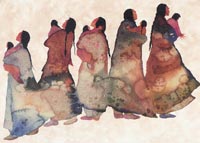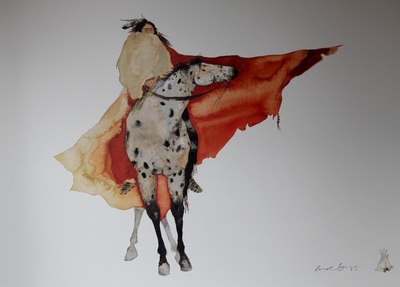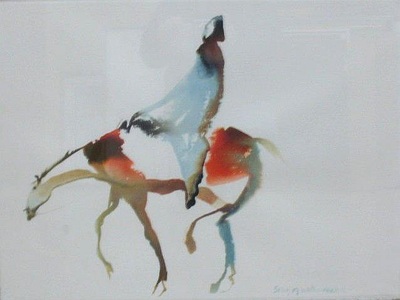In looking for artists to include in my personal anthology for English, I came upon Carol Grigg. She is a Cherokee painter from Oregon, and I love the way she uses watercolors. She manipulates the watermark in such a way that provides for tremendous texture and movement in her work. I also like the way that she uses negative space in many of her compositions to create drama and suspense. The clean outside edges and distinct defining lines of many of her figures juxtaposed to the fuzzy washes of color within them gives her work an intriguing rhythm that I am drawn to--a constant shifting of soft to sharp, a satisfying balance of spontaneity and control.
|
The beautiful Spring day called for a walking field-trip! Despite the fact I was running on a about an hour and a half of sleep, it still managed to be another great one. First stop was a student exhibition center on the VCU campus. Unfortunately, I only have one picture from the craft exhibit. This picture features a sculpture of a tall wood block with a jumble of wire and a couple of bricks at the top. At the bottom, among a few other bricks, is what looks to be a deformed teapot. I think I was drawn to the sculpture because of its use of natural elements--wood, earth, metal. However, these elements are not depicted in their natural forms, but instead in the way that humans manufacture them in order to build and construct--hence the wires, the bricks, and the wooden beam. I now look at this piece, seemingly simple at first glance, and see a statement about the foundations of our society--the building blocks that we produce in mass quantities to serve as structure for our constructs. Though the structure may collapse, the building blocks remain. This work has inspired me not only to use a variety of natural elements in my own sculpture, but has also shown me the the powerful message a collection of found objects can convey through their unique composition. At the 1708 Gallery, Andrew Kozlowski provokes similar questions in his exhibit "After the Party". I felt the exhibit as a whole to be very chaotic and overwhelming. Though it did not appeal to me on a superficial level, I think the chaos was intentional on Kozlowki's behalf. Not only did he have to consider the composition of each piece of work, but he had to carefully take into account the composition of the whole room. He uses the space in away that really emphasizes how modern man scatters his many belongings. He takes the saying "leaving a trail" to a whole other level by making a mountain out of his prints of our everyday items. After 1708 Gallery, we go the chance to stop by Quirk for a short while. There, I was most intrigued by the work of Amy Rice. The body of work she had on display included multiple paintings of birds and flowers. I really enjoy how she paints on top of maps and other documents. I believe that now I am more likely to consider my canvas or the surface that I plan to work on just as much as the work itself. Painting on unique surfaces provides her content with interesting textures and also gives depth to pieces that would otherwise seem a little flat. |
AuthorMLWGS Art III student Archives
April 2014
Categories |




 RSS Feed
RSS Feed
